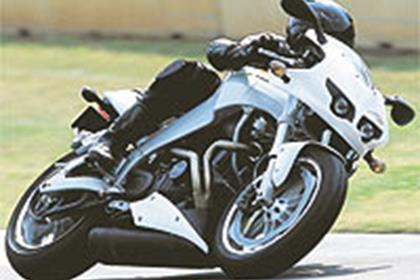First pictures of Buell’s fast-turning ‘Sport Fighter’
Buell’s all new Firebolt has a wheelbase 75mm shorter than an R1’s and a steering head angle so steep that it’s likely to become known as the world’s fastest turning production bike.
To prevent it becoming the most unstable, it’s been designed to keep all the weight low and central with cute ideas like filling the new beam frame with fuel and making the swingarm its oil tank.
Buell reckons it defines a new niche – calling it a ” Sport Fighter ” , and aimed at maximum real-world performance rather than headline-grabbing power or top speed figures.
The engine might look like the usual, air-cooled, Harley-based V-twin powering the rest of Buell’s range, but it’s a totally new design developed jointly by Harley and Buell specifically for the Firebolt.
It’s still a 45-degree, air-cooled twin with two valves per cylinder, operated by pushrods, but while it sounds old-fashioned there’s plenty of technology there.
At 984cc, it has a totally different bore and stroke to other Harley engines and it’s compression ratio of 10:1 is closer to that of a Japanese superbike than an American cruiser.
To maximise the power, the motor uses ram-air and fuel injection – resulting in 95bhp at 7200rpm and an impressive 68ftlb of torque at just 5500rpm. Combined with the Firebolt’s chassis it promises to make for an exciting ride.
The frame is a totally new design. While most Buells use a steel trellis, the Firebolt has a massive aluminium beam frame and the bike’s fuel is actually stored inside the frame rails – sitting near the swingarm pivot to keep the centre of gravity as low as possible.
The chassis uses the engine as a stressed member, again cutting the weight, but thanks to a patented engine mount system, the motor isn’t rigidly mounted – so vibrations aren’t carried straight through to the rider.
There’s also a novel swingarm. It stores the engine oil in a reservoir near the swingarm pivot – again keeping the weight towards the centre of the bike.
All this advanced packaging has helped Buell create a machine that is tiny given its near-1000cc capacity. The wheelbase is just 1320mm – a full 75mm shorter than Yamaha’s R1!
And the steering head angle is just 21 degrees, where 23 or 24 is usually considered steep.
Both the upside-down forks and rear shock are Japanese Showa units, adjustable for compression, rebound and pre-load. The rear shock doesn’t have the rising rate linkage you normally find on sports bikes, instead it is mounted directly between the frame and swingarm – reducing weight and allowing a shorter wheelbase.
The brakes are also a first for a production bike. The single front disc is mounted to the wheel rim rather than the hub – a system Buell calls ” Zero Torsion Load ” or ZTL. Buell claims that because the braking forces are applied directly to the wheel rim rather than being transmitted through the wheel spokes, the front wheel can be far lighter than a conventional design. This helps reduce unsprung weight to let the suspension work better and reduces the gyroscopic forces to allow the bike to turn faster.
Although there’s only one disc where you would normally expect two, at 370mm it’s got a bigger diameter than most bikes’ brakes. That means it can run cooler and get better stopping power. The disc is gripped by a six-pot caliper.
Overall, the bike tips the scales at just 175kg – the same as Yamaha’s R1. So even with less than 100bhp, the performance should be lively enough for most.
The faring is made of a material called Surlyn, which has the colour moulded into it, so there’s no need for painting. Another advantage is that scratches can simply be polished out as the colour runs all the way through.
The company’s boss, Erik Buell, said: ” We knew we had to communicate the innovation of the product, evolve the unique Buell look and take motorcycle styling to a new level. We weren’t after traditional full-bodied sports bike styling but something much more minimal and essential. A new category of motorcycle called ‘Sport Fighter’. ”
The nose fairing is held in place by a magnesium casting that also carries the futuristic projector-beam headlights and the instrument panel. Even the instruments are new – with no less than three trip counters! Two can be operated normally, while the third starts running automatically when the low fuel light comes on. In keeping with the practical aspect of the bike, there’s even a clock – something that is still missing from many sports bikes.
Buell expects the bike to go on sale before the end of the year for around £8000.
The current X1 and M2 Cyclone will continue to be sold alongside the new bike.


